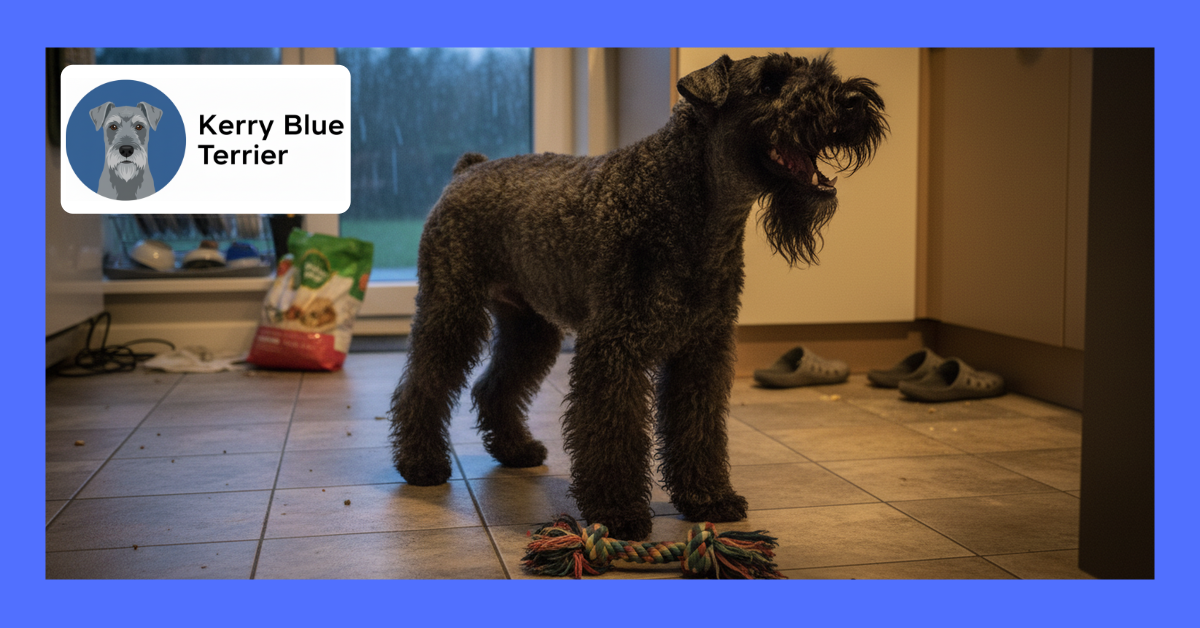Are you considering a Kerry Blue Terrier as your family’s next guardian? This distinctive Irish breed has sparked countless debates among dog enthusiasts about their true protective capabilities.
Kerry Blue Terriers make excellent watchdogs but are not traditional guard dogs. They excel at alerting families to potential threats through their natural vigilance and protective barking, but lack the size and specialized training typically required for physical protection work.
Understanding the difference between a watchdog and a guard dog is crucial when evaluating whether this spirited terrier fits your family’s security needs. Let’s explore what makes Kerry Blues effective home protectors and where their limitations lie.
Understanding Kerry Blue Terrier Protective Instincts
Kerry Blue Terriers were originally bred in Ireland as multipurpose working dogs. Their historical roles included guarding livestock, hunting vermin, and serving as farmyard watchdogs. This diverse background shaped their naturally alert and protective temperament.
These medium-sized terriers typically weigh 33-40 pounds and stand 17.5-19.5 inches tall. Their compact size makes them less intimidating than traditional guard breeds, but their fearless attitude often compensates for their physical limitations.
The breed’s protective instincts manifest in several key ways:
- Territorial awareness: They quickly identify their family’s property boundaries
- Stranger alertness: Kerry Blues naturally assess unfamiliar people with caution
- Vocal warnings: They use barking as their primary deterrent mechanism
- Family loyalty: These dogs form intense bonds with their households
Watchdog vs Guard Dog: Key Differences
Many people confuse watchdogs with guard dogs, but these roles require different skills and temperaments. Understanding this distinction helps clarify where Kerry Blue Terriers excel.
| Characteristic | Watchdog | Guard Dog |
|---|---|---|
| Primary Function | Alert and deter | Alert and physically protect |
| Training Required | Basic socialization | Specialized protection training |
| Size Requirements | Any size effective | Usually large breeds (60+ lbs) |
| Aggression Level | Controlled barking | Trained controlled aggression |
| Kerry Blue Suitability | Excellent | Limited |
Kerry Blue Terriers naturally excel as watchdogs. Their keen senses detect unusual sounds, movements, or unfamiliar visitors quickly. However, their medium size and terrier temperament make them less suitable for true guard work requiring physical confrontation.
What Makes Kerry Blues Effective Watchdogs
Several breed characteristics contribute to their watchdog effectiveness. Kerry Blues possess exceptional hearing and remain alert to environmental changes throughout the day and night.
Their bark serves as an excellent deterrent. Most potential intruders avoid homes with vocal, alert dogs, regardless of the dog’s actual size. Kerry Blues deliver this vocal warning consistently and convincingly.
The breed’s natural suspicion of strangers adds another protective layer. Unlike overly friendly breeds that welcome everyone, Kerry Blues maintain appropriate caution around unfamiliar people.
Training Your Kerry Blue Terrier for Home Protection
Proper training transforms a Kerry Blue’s natural instincts into reliable home protection. Without guidance, their protective nature can become problematic through excessive barking or territorial behavior.
Essential Training Steps
Follow these steps to develop your Kerry Blue’s protective abilities while maintaining control:
- Establish clear boundaries: Teach your dog which areas they should patrol and protect
- Control the alert response: Train specific commands like “watch” and “enough” to manage barking
- Socialize extensively: Expose your Kerry Blue to various people, situations, and environments early
- Reinforce calm confidence: Reward composed alertness rather than frantic excitement
- Practice stranger protocols: Train your dog to alert but remain under your control when visitors arrive
Consistency is crucial during training. Kerry Blues are intelligent but strong-willed, requiring patient, positive reinforcement techniques rather than harsh corrections.
Common Training Challenges
Kerry Blue Terriers present unique training challenges that owners must address. Their terrier independence can lead to selective listening, especially when they believe they’re protecting their family.
Some Kerry Blues develop overprotective tendencies without proper socialization. This can result in excessive barking at delivery drivers, neighbors, or other dogs during walks.
Their strong prey drive may cause them to chase small animals, potentially abandoning their guarding duties. Training helps maintain focus on actual security threats.
Kerry Blue Terriers vs Traditional Guard Dog Breeds
How do Kerry Blues compare to breeds specifically developed for protection work? This comparison helps set realistic expectations for potential owners.
Traditional guard dog breeds like German Shepherds, Dobermans, and Rottweilers typically weigh 70-130 pounds. Their size alone creates a significant deterrent effect that Kerry Blues cannot match.
However, Kerry Blues offer advantages in certain situations:
- Apartment living: Their moderate size fits smaller living spaces better
- Family compatibility: Less risk of accidental injury to children during play
- Lower liability: Reduced insurance and legal concerns compared to larger protection breeds
- Grooming benefits: Their hypoallergenic coat suits families with allergies
When Kerry Blues Excel
Kerry Blue Terriers perform best in specific protection scenarios. They excel at protecting homes where early warning is more valuable than physical deterrence.
Urban and suburban environments suit their skills particularly well. Their barking alerts neighbors and draws attention to potential problems, creating community-wide security benefits.
Families seeking a dual-purpose pet find Kerry Blues ideal. They provide reliable security awareness while serving as loving, intelligent companions.
Real-World Protection Scenarios
Understanding how Kerry Blue Terriers respond in actual protection situations helps owners set appropriate expectations. These dogs rarely engage in physical confrontation but excel at deterrence through presence and vocalization.
During nighttime disturbances, Kerry Blues typically position themselves between their family and potential threats while barking to alert household members. This behavior effectively deters most casual intruders.
Their territorial nature makes them particularly effective at protecting vehicles, yards, and homes from opportunistic crimes. However, they’re less suitable for deterring determined intruders willing to face physical resistance.
Limitations to Consider
Kerry Blue Terriers have important limitations as guard dogs that owners must acknowledge. Their medium size makes them vulnerable to larger, more aggressive threats.
Some Kerry Blues may become overly reactive, barking at benign stimuli like delivery trucks or children playing nearby. This can create neighborhood tensions and reduce the effectiveness of genuine alerts.
Their strong-willed nature requires experienced handling. First-time dog owners may struggle to properly channel their protective instincts without professional training assistance.
Health and Maintenance Considerations
Maintaining a Kerry Blue Terrier’s protective capabilities requires attention to their physical and mental health needs. These active dogs require regular exercise to prevent behavioral problems that could interfere with their guarding duties.
Their distinctive coat requires professional grooming every 6-8 weeks. A well-groomed Kerry Blue presents a more impressive appearance, potentially enhancing their deterrent effect.
Mental stimulation through training, puzzle toys, and varied activities keeps Kerry Blues engaged and responsive. Bored terriers often develop destructive or overly vocal behaviors.
Proper nutrition supports their energy levels and alertness. High-quality food helps maintain the stamina needed for effective watchdog duties throughout their 12-15 year lifespan.
Are Kerry Blue Terriers Right for Your Security Needs?
Kerry Blue Terriers offer excellent watchdog capabilities for families seeking alert, intelligent companions with protective instincts. They excel at early warning systems and deterrence through vocal alerts and confident presence.
However, families requiring serious physical protection should consider larger, specialized guard dog breeds. Kerry Blues work best when their role focuses on detection and deterrence rather than confrontation.
The ideal Kerry Blue owner understands the breed’s needs for training, socialization, and mental stimulation. These dogs reward dedicated owners with unwavering loyalty and reliable home protection within their natural capabilities.
Before choosing a Kerry Blue Terrier as your family’s protector, honestly assess your security needs, living situation, and commitment to proper training. When matched correctly, these remarkable dogs provide years of faithful service as both guardians and companions.
Frequently Asked Questions
Do Kerry Blue Terriers bark a lot?
Kerry Blue Terriers are moderate barkers who typically vocalize when alerting to strangers or unusual activity. With proper training, their barking can be controlled and directed toward genuine security concerns rather than excessive noise.
Can Kerry Blue Terriers protect against intruders?
Kerry Blue Terriers excel at deterring intruders through alerting and barking but are not physically equipped for serious protection work. Their medium size and terrier temperament make them effective watchdogs rather than guard dogs.
Are Kerry Blue Terriers aggressive toward strangers?
Well-socialized Kerry Blue Terriers show appropriate caution around strangers without unprovoked aggression. They typically remain alert and watchful but should not display hostile behavior toward properly introduced visitors or passersby.
How early should I start guard dog training with my Kerry Blue Terrier?
Begin basic socialization and obedience training with Kerry Blue Terriers between 8-16 weeks old. Early exposure to various people, situations, and controlled protection scenarios helps develop their natural watchdog instincts appropriately.
Do Kerry Blue Terriers get along with other pets while guarding?
Kerry Blue Terriers can coexist with other pets when properly socialized, but their terrier nature may create conflicts with same-sex dogs. Early introduction and consistent training help maintain harmony while preserving their protective instincts.
What size home is best for a Kerry Blue Terrier guard dog?
Kerry Blue Terriers adapt well to various home sizes, from apartments to large properties. Their moderate size and exercise needs make them suitable for most living situations, though they benefit from secure outdoor access for patrolling.
How much does it cost to train a Kerry Blue Terrier for protection work?
Basic obedience and socialization training for Kerry Blue Terriers typically costs $500-1500, while specialized protection training ranges from $1000-3000. Most families find basic watchdog training sufficient for their Kerry Blue’s natural protective abilities.

